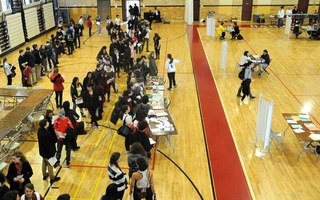Though data suggests that more Harvard undergraduates are admitted to Stillman Infirmary for alcohol intoxication or poisoning, it remains unclear whether the increase in volume means that students are drinking in greater quantities than before.
The number of undergraduate students seeking treatment for alcohol-related illnesses at University Health Services is likely to rise for the second straight academic year, according to data provided by the Office of Alcohol and Other Drug Services. The figure will likely reach roughly 200 by the end of the spring term.
If AODS’ predictions are correct, the figure represents a 43 percent increase in the past two years, marking an upward trend after a period of stabilization from 2005 to 2008.
According to Harvard officials involved in alcohol and drug education on campus, there remains no definitive reason for the up-tick in Stillman admissions, but they hypothesize that the answer lies in a combination of the College’s amnesty policy and nation-wide increase in alcohol consumption as a result of stress from the economic climate.
COLD BEERS, HARD FACTS
Among Harvard undergraduates who consider themselves drinkers, about 73 percent consume between zero and four drinks on a typical night. The remaining 27 percent of students engage in high-risk or binge drinking, according to AODS’ data, and the figure is well below the national average of college students who engage in binge or high-risk drinking.
While the number of alcohol-related hospitalizations is on the rise, the number of undergraduates who require ambulance assistance because they have reached an inordinate degree of intoxication has remained constant, hovering at around 40 cases a semester, according to AODS Director Ryan M. Travia. These students often have the highest blood alcohol levels, he added.
Despite such promising figures, more Harvard freshmen engage in “pregaming” than those at other schools nation-wide. At Harvard, 42 percent of freshmen drinkers pregame, and 39 percent of freshmen drinkers take shots—both percentages are higher than national figures.
Indeed, Travia noted that most Stillman admissions are related to the consumption of hard alcohol, often consumed during pregames.
“We have an inordinately high percentage of students that report drinking hard alcohol,” Travia said. “Virtually every single student we see at Stillman, it’s hard alcohol. Most of the time it’s shots—and if you want to be really specific, vodka.”
Still, this year’s freshman class contains a greater number of heavy drinkers, in addition to more abstainers—a description that fits the national trend, according to Travia.
“Nation-wide, we’re seeing increases at both ends of the spectrum,” he said. “We’re inheriting more students coming to Harvard that are identifying as abstainers or non-drinkers, and more students showing up who are already drinking in very problematic ways. Theoretically, some of those students at the higher end might be showing up in UHS.”
Travia said there is no clear indication that this year’s freshman class has inflated the number of students in need of care. Nevertheless, freshman have consistently comprised about half of those hospitalized for alcohol-related illnesses, continuing the pattern.
The increase in the number of students admitted to UHS for alcohol-related illness does not represent a change in the percentage breakdown by class year.
“The fact that it’s occurring through all four years means that something’s happening throughout the college,” said Director of Behavioral Health and Academic Counseling Paul J. Barreira.
Read more in News
Schedule Change Amplifies Stress Among StudentsRecommended Articles
-
More Intoxicated Undergraduates Treated at UHSThe number of undergraduate students seeking treatment for alcohol intoxication or poisoning at University Health Services is likely to rise for the second straight academic year.
-
Ryan M. Travia: Living a Life of SubstanceFor the past five years, Travia has served as the director of the Office of Alcohol and Other Drug Services. His role involves organizing Harvard’s alcohol education programs, working with treatment providers at University Health Services, and developing policy-based initiatives for the University related to alcohol and drug use.
-
Alcohol Check-In Sees Record CrowdDrawn by the promise of free water bottles, more than 1,330 students flocked to the Malkin Athletic Center last Friday for National Alcohol Screening Day, marking a record level of participation that rose by almost 40 percent from last year.
-
 DAPA Stages Screening Day
DAPA Stages Screening Day -
UHS Admits Down from 2010The number of students admitted to Harvard University Health Services for alcohol-related illnesses this semester has decreased after spiking last spring, Director of the Office of Alcohol and Other Drug Services Ryan M. Travia said during a talk with students about alcohol policy
-
Don’t Be Fooled By UHSAttempting to use undisclosed statistics as evidence for the success of new anti-drinking policies turns what should be an open discussion on the subject into a kangaroo court, where only those rendering the verdict have seen the evidence.













